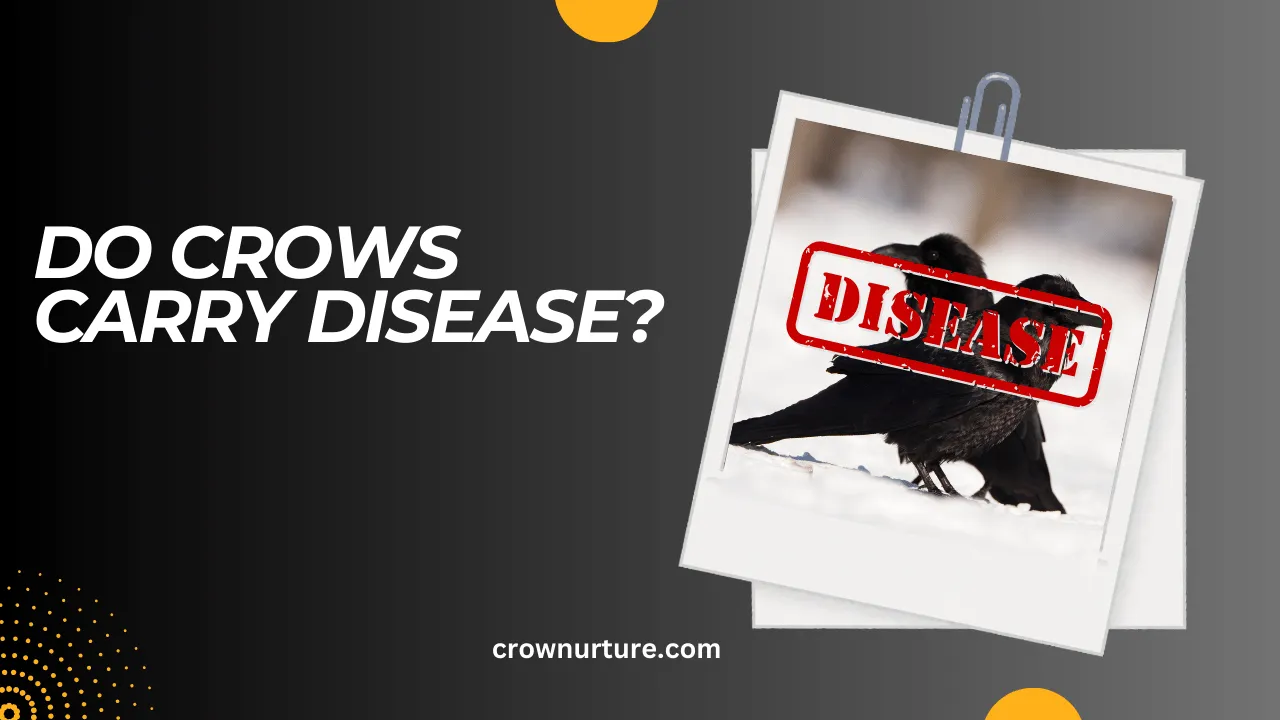Crows, with their sleek black feathers and sharp intelligence, are some of the most fascinating birds in the animal kingdom. Known for their adaptability, problem-solving skills, and unique ability to thrive in urban environments, crows often share their habitats with humans.
However, their increasing presence near homes, parks, and public spaces has sparked a pressing question: Do crows carry diseases, and are they dangerous to human health?
This question is more relevant than ever, especially in cities where human-wildlife interactions are unavoidable. Like any wildlife, crows play a role in ecosystems but can also harbor pathogens that have the potential to harm humans and pets.
The risks of disease transmission can occur directly or indirectly, making it crucial to understand how these birds interact with their environment and the health precautions we should take.
In this article, we’ll break down the facts about diseases carried by crows, how these diseases are transmitted, and the best practices to prevent potential risks. You’ll also learn about the ecological benefits of crows and how to coexist safely with these intelligent birds.
Let’s dive in and uncover what you need to know to keep yourself and your environment safe while appreciating crows for their ecological role.

Contents
1. Diseases Carried by Crows
Crows, like many other birds, can carry pathogens that cause diseases in humans or animals. Here are some key diseases associated with crows:
- West Nile Virus: Crows are known carriers of West Nile Virus, a mosquito-borne disease that can infect humans. Crows themselves often die quickly after contracting the virus, which makes them an indicator species for the spread of West Nile Virus in an area. While the virus is not transmitted directly from crows to humans, mosquitoes feeding on infected crows can spread it to people.
- Histoplasmosis: Crow droppings can harbor a fungus known as Histoplasma capsulatum, which causes Histoplasmosis—a lung infection in humans. When dry droppings are disturbed, the fungal spores can become airborne, posing a risk to anyone inhaling them. Although the disease is rare, it is more dangerous for individuals with weakened immune systems.
- Salmonella: Crows may carry Salmonella bacteria, which can contaminate food, water, or surfaces. Humans can become infected by accidentally touching contaminated areas or consuming contaminated food. Symptoms of Salmonella infection include diarrhea, fever, and stomach cramps.
While crows can carry these diseases, the actual risk of infection is relatively low for people who practice good hygiene and take precautions.
2. Transmission Routes
Understanding how diseases are transmitted helps reduce risks. There are three main ways diseases linked to crows can spread:
- Direct Contact: Handling crows, their droppings, feathers, or nests without protective measures can expose individuals to harmful bacteria or fungi. Although crows rarely allow humans to touch them, accidental exposure may occur if you’re cleaning areas where they roost.
- Indirect Contact: Disease-causing pathogens can spread through contaminated surfaces, food, or water sources. For example, crow droppings on patios, cars, or outdoor furniture can be unknowingly touched, and pathogens can transfer to the hands or food.
- Vector-Borne Transmission: Mosquitoes and ticks feeding on infected crows can act as vectors to transmit diseases like West Nile Virus to humans or animals. This indirect route highlights the importance of controlling mosquito populations in crow-dense areas.
By understanding these transmission methods, you can adopt simple strategies to limit your exposure and stay healthy.

3. Prevention Measures
The good news is that the risks of disease from crows can be managed through basic precautions. Here’s what you can do:
- Avoiding Direct Contact: Never touch live or dead crows with bare hands, and avoid contact with their feathers, nests, or droppings. If contact is unavoidable, wear gloves and wash your hands thoroughly afterward.
- Sanitation: Regularly clean and disinfect outdoor surfaces such as patios, cars, bird feeders, and garden furniture that may have crow droppings. Use a mixture of water and mild disinfectant to eliminate harmful pathogens.
- Protective Gear: When cleaning crow droppings, always wear gloves, masks, and protective clothing to minimize exposure to fungal spores or bacteria. Avoid sweeping dry droppings as this can spread particles into the air—dampen the area first.
- Proper Waste Disposal: Crows are scavengers and are drawn to easily accessible food sources. Keep your garbage bins tightly sealed and dispose of food waste properly to deter crows from gathering near your home.
- Mosquito Control: Since mosquitoes spread West Nile Virus, eliminate standing water in your yard where mosquitoes breed. This reduces both mosquito populations and the chances of transmission.
Simple steps like these significantly reduce the risk of disease, ensuring safer coexistence with crows.
4. The Role of Responsible Bird Feeding
Feeding birds can be enjoyable, but it’s important to understand its unintended consequences, especially with species like crows:
- Attracting Pests: Food meant for crows or other birds can attract unwanted wildlife, such as rodents or raccoons, which may carry diseases themselves. Feeding areas can quickly become unsanitary if not maintained.
- Disease Transmission: Overcrowded feeding areas increase the risk of disease spread among birds. Crow droppings in bird feeders or water bowls can also expose other animals to harmful bacteria or fungi.
- Responsible Feeding Practices: If you choose to feed crows, ensure food is placed in a controlled environment. Clean feeders regularly, provide only small portions, and avoid leaving food that can spoil or attract pests. This reduces the risk of disease transmission and keeps the feeding area healthy.
By practicing responsible feeding, you can minimize health risks while still enjoying interactions with these intelligent birds.
5. The Benefits of Crow Populations
Despite concerns about disease, crows provide significant ecological benefits:
- Pest Control: Crows feed on insects, rodents, and other small animals, helping to control pest populations naturally. By consuming pests like grasshoppers, caterpillars, and even small rodents, they contribute to the balance of local ecosystems.
- Seed Dispersal: As scavengers, crows often feed on fruits and nuts, dispersing seeds across wide areas. This behavior supports forest regeneration and plant diversity.
- Cleaning the Environment: Crows are nature’s cleanup crew, eating carrion (dead animals) and organic waste. This helps prevent the spread of harmful bacteria from decomposing matter in urban and natural settings.
Maintaining a healthy balance between appreciating the ecological role of crows and mitigating health risks is key to peaceful coexistence.
Conclusion
While crows can carry diseases like West Nile Virus, Histoplasmosis, and Salmonella, the risks to humans are generally low with proper precautions. Understanding how diseases are transmitted—through direct or indirect contact, and via mosquitoes—helps individuals take the necessary steps to protect themselves and their surroundings.
Simple habits such as maintaining cleanliness, avoiding direct contact with crows and their droppings, and practicing responsible bird feeding can greatly minimize health risks. At the same time, it’s important to recognize the ecological benefits of crows, from pest control to seed dispersal, which highlight their valuable role in the environment.
By balancing caution with appreciation, we can safely coexist with these intelligent birds while protecting public health.
FAQs
1. Are crows dangerous to humans?
Crows are generally not dangerous to humans, but avoiding direct contact with them and their droppings is advised.
2. Can crows transmit diseases to pets?
Yes, pets can become infected if they come into contact with crow droppings, contaminated water, or food.
3. How can I prevent crows from roosting in my yard?
Use reflective objects, secure food waste, and limit standing water to discourage crows from gathering.
4. What is West Nile Virus, and how does it spread?
West Nile Virus is a mosquito-borne illness that spreads to humans when mosquitoes bite infected birds like crows.
5. Can touching crow droppings make you sick?
Yes, crow droppings can contain harmful pathogens like Histoplasma and Salmonella, so always use gloves when cleaning.
6. How do I clean areas contaminated by crow droppings?
Use water, disinfectant, gloves, and masks to clean surfaces safely and avoid sweeping dry droppings.








